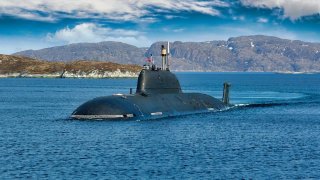Russia's Akula-Class Attack Submarines Had Just 1 Mission
Russia's Akula-class submarines, first deployed in the mid-1980s, remain a cornerstone of the country's naval force. Designed to counter any submarine or surface warship, including those of the U.S. Navy, these nuclear-powered SSNs boast exceptional stealth capabilities that still challenge anti-submarine warfare specialists today.
Bottomline: Russia's Akula-class submarines, first deployed in the mid-1980s, remain a cornerstone of the country's naval force. Designed to counter any submarine or surface warship, including those of the U.S. Navy, these nuclear-powered SSNs boast exceptional stealth capabilities that still challenge anti-submarine warfare specialists today.

Summary and Key Points:
-Built between 1986 and 1995, the Akula-class features double-hulled configurations and advanced noise-reduction technology. The class includes various enhanced models, like the Akula II, which surpasses even American submarines in acoustic stealth. Despite their age, incremental upgrades have kept these formidable vessels relevant. However, incidents like the tragic Nerpa fire highlight the risks associated with these powerful submarines.
-Russia’s Akula-class may be nearing their third decade but continue to seem to be the mainstay of the country’s nuclear attack submarine sea-based force. They were designed to compete and sink any submarine or surface warship on the planet - and that means the U.S. Navy for sure.
-First deployed by the Soviet Navy back in the mid-1980s, Project 971 “Shchuka-B” is a family of fourth-generation nuclear-powered SSNs equipped with stellar acoustic stealth capabilities. In fact, anti-submarine warfare specialists today struggle to detect the Akula-class ships despite technological advances.
A Brief History Of The Akula-Class from Russia
Back in the early 1970s, the new Project 971 was approved by Soviet officials. Each submarine in this class was constructed by the Amur Shipbuilding Plant Joint Stock Company at the Severodvinsk shipbuilding yard. Seven of these submarines were constructed and commissioned between 1986-1992. Three enhanced Akula ships also entered service between 1992 and 1995, designated as Project 971U and Project 971A. The premier ship in the class is the Akula, followed by the Ak Bars, Barnaul, Kashalot, Pantera, Volk, Bratsk, Leopard, Tigr, Magadan, Vepr, Kuzbass, Gepard, Kuguar, Rys, Samara, Nerpa and Iribis. In total, 20 Akula-class submarines were laid down, although several were never completed.

One OK-650B pressurized water reactor powers each Akula-class submarine, rated at 190 MW. The Akula SSNs were not the first ships in the Soviet’s arsenal to be powered by this source, which delivers thermal power from the reactor via steam turbine to one shaft. Previous boats, including the Sierra I, Sierra II, and Mike-class submarine, were also powered by the OK-650. In fact, the same reactor is still used to power some of Russia’s more modern boats like the Graney- and Borei-classes.
Perhaps the greatest characteristic featured by the Akula-class submarines is their quietness. Each ship in this class is remarkably more silent than past Soviet submarine designs. In fact, its stealth really surprised Western countries, which became worried that the Akula-class could out-match its own counterparts. According to Military Today, the use of commercially available Western technology aimed to reduce noise levels helped the Akula-class break the long-held North Atlantic Treaty Organization (NATO) advantage in the seas during the Cold War.
Each Akula-class submarine features a double-hulled configuration with a unique high aft fin. Seven compartments exist within the hull. Over the years, incremental design enhancements have helped the Akula ships retain a minimized acoustic signature, including the addition of active noise cancellation techniques. In terms of armaments, the Akula class is armed to the teeth. Each submarine in this class can carry up to one dozen Granit submarine-launched cruise missiles, which are fired from the 533mm torpedo launch tubes. The Akula-class’ anti-ship missiles are also quite formidable. The Novator SS-N-15 Starfish and the Novator SS-N-16 Stallion have ranges of 45km and 100km respectively. Both anti-ship missiles can be armed with a 200kt warhead or a type 40 torpedo, according to Naval Technology.
Introducing The Akula-II Submarine
The only Akula II submarine to ever be completed is the Vepr. This submarine measures 3m longer than its sister ships and displaces roughly 700 tons more. When the Vepr was introduced to service, it became the first Russian submarine that had a lower acoustic signature than the American-made Los Angeles class submarines. The improved Akula II ships are also fitted with an additional 533mm external torpedo tube. While the Akula II ships are superior to their counterparts, Russian shipyards have struggled to complete additional submarines due in part to cost. Each Akula II ship is reportedly associated with a $1.55 billion price tag back in 1996 (roughly $2.4 billion today). Since Russia was just emerging as a post-USSR country, budgets were limited making the expansion of sophisticated submarines a money issue.
The Tragic Nerpa Incident
In November 2008, the K-152 Nerpa was cruising beneath the waters of the Sea of Japan on sea trials when a tragic incident would take the lives of many onboard. On this day, two forward compartments of the Nerpa were sealed and flooded with firefighting gas. Twenty individuals perished on this day and forty more were injured.
While the cause of the disaster was not immediately clear, some experts believe that the new firefighting system installed on the submarine had malfunctioned and deployed the gas by mistake. The Nerpa tragedy was not the first time Russian submarines suffered from a fire. In 1984, the Soviet submarine Komsomolets was lost due to an uncontrolled fire on board.
About the Author
Maya Carlin is an analyst with the Center for Security Policy and a former Anna Sobol Levy Fellow at IDC Herzliya in Israel. She has by-lines in many publications, including The National Interest, Jerusalem Post, and Times of Israel. You can follow her on Twitter: @MayaCarlin.


